I moved to England over 3 years ago, to a house I had only seen in pictures and a virtual visit. It was the end of the pandemic and I wanted a house with a garden after being very cozy in a flat in Berlin with my husband and my then toddler (now 7yo girl).
This house had a good garden, even if quite naked and really not that fun or colourful. It had a manicured lawn and a few bushes.
I come from Brazil, where gardening is really just watering your private little jungle, where anything you put on the ground will eventually bloom and spread. I never learned the structured and seasonal gardening skills all my English neighbours seem to share and enjoy.
My first year in England I spent recuperating from the deep xenophobia I suffered in Germany during the prior 4 years of my migration. From my sunny home country I encountered a lot of disconnection and fear in this new immigrant life (maybe I'll write more about it someday). So my body and mind were quite fragile and my time spent in the garden was trying to get the rare English sunshine, playing with my daughter, my cats, and getting to know what wild life comes to visit. It was a year of restoration.
The second year I started resenting the garden a little. I cleaned tons of debris and rubbish I found buried in the earth, something I found very strange, and discovered later is quite common after a house has been remodelled here in this country. Lots of things died. It didn't really bloom or grow anything other than beautiful wild flowers, which I would gladly leave, except my landlord was not happy about it. Then the ants made a home of the lawn, and I'd be happy to let them, but again... not my lawn. I couldn't give the garden the energy I thought I had to. I was trying to build community for me and my family, finding ways to get to the local women with my work. It was a year of restructuring.
We are now deep into the third year, and I feel something stir in me.
The garden has been here the whole time.
Waiting. Watching me come and go.
It doesn't rush me, or ask anything of me. It simply holds its ground.
It took me three years to plant something in this garden.
Three years of telling myself, “It’s a rental.” “I might leave.” “I don’t want to get too attached.” "I don't wanna invest my money and energy on other people's property".
But the truth beneath that is simpler, and harder: I was (am) afraid to take space. To belong temporarily and then leave. To claim a patch of earth as mine, even if just for now.
Because what if I have to say goodbye? What if it is taken away? What if I allow myself to belong, and then have to leave?
I know that feeling in my body. I’ve carried it through countries, relationships, and homes.
The ache of impermanence.
The way we’re taught - especially as women, as immigrants, as survivors - not to get too comfortable.
The habit of hovering just above the ground, pretending not to care if I stay.
So many of us live this way: inhabiting just above the soil of our lives, always ready to move, to leave, to disappear quietly before anyone notices we ever arrived. We are taught that not putting down roots is safer. Cleaner. Less painful.
Nobody can uproot you if you never had roots anyway.
Maybe it's safer to be a hydroponic lettuce: bland, clean, rootless.
But in me there's a quiet sorrow in never arriving fully. In holding myself at the threshold of my own life. I've been doing that for so long… and not just in the garden.
And then one soft spring morning, I planted a rhododendron (And when I say 'I', I mean my husband dug the hole… so really, it was more of a 'we').
It was on sale at the garden centre. I asked a gardener if there was something wrong with it. She replied:
“It won't bloom unless it's planted on the ground.”
And that was all I needed to have a new beginning.
The day before was mother's day in the UK and my husband and daughter had a surprised planned for me. We got in the car and half an hour later I found myself standing inside (yes, inside) the Ankerwycke Yew.
The Ankerwycke Yew
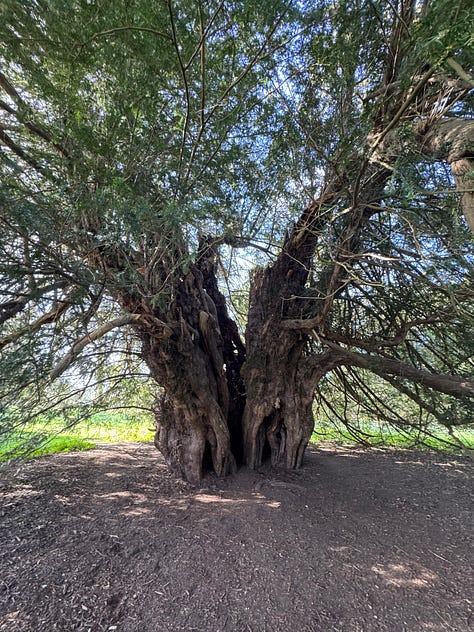
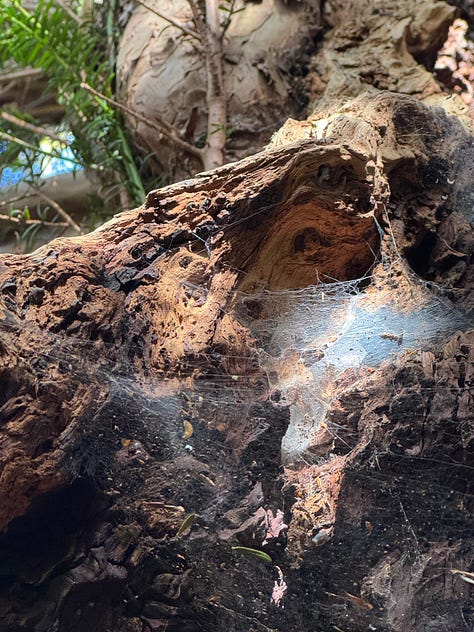


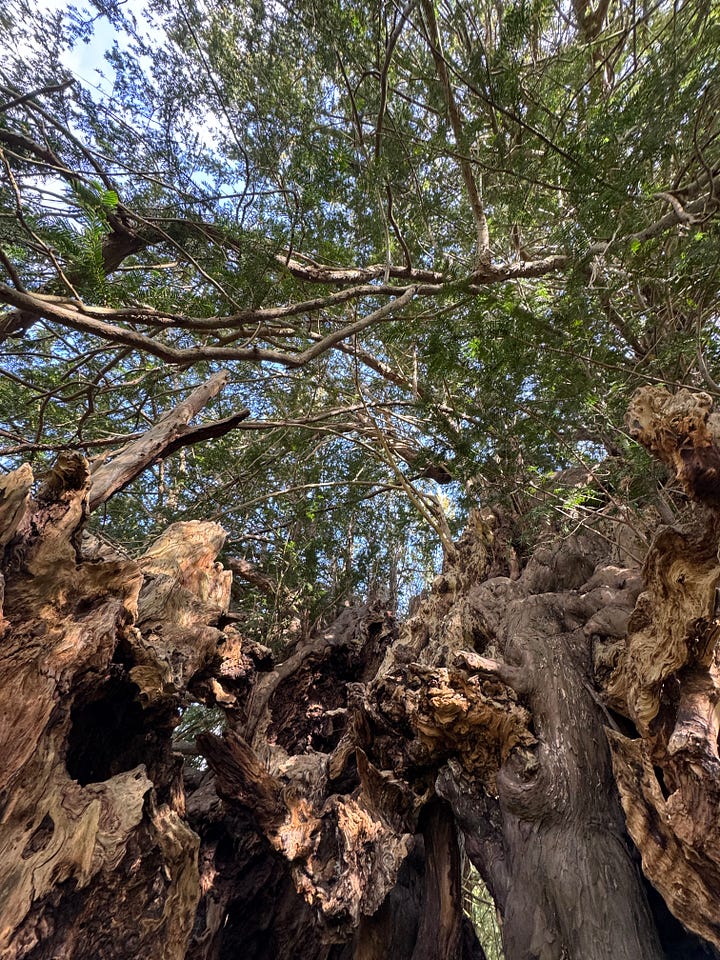
This tree is estimated to be over 2,000 years old. Older than any of my fears, excuses, reasonings. Older than the stories of kingdoms and religions that shaped this land. Older than the languages I use to name what hurts and what heals.
This Yew Tree has stood as a silent witness to generations of people who came seeking something they couldn’t quite name. Perhaps healing. Perhaps truth. Perhaps themselves.
In Celtic folklore, Yews are considered guardians of the liminal, the space between life and death, between what has been and what might yet become. Their roots, tangled deep in mystery, touch the edge of what we can hold and what must be surrendered.
The Ankerwycke Yew in particular has seen many stories. It grows near the ruins of a priory once dedicated to Mary Magdalene. It has stood beside the Thames, near where the Magna Carta was sealed. It could have witnessed Henry VIII having an affair with Anne Boleyn.
And it once carried, deep in its hollowed heart, the myths of fairy magic and offerings: clooties tied to its branches with whispered prayers, left to the mercy of time.
I’ve always known that trees are Beings. Not just symbols or scenery but alive in the deepest, most soulful way. When I first read about the Ents in Tolkien’s stories (the only part that interested me, to be honest) those ancient, walking trees who rise to protect the innocent, I didn’t think of it as fantasy. I thought: Yes. Of course. That’s exactly how trees are. They stand watch. They listen. And if they needed to, they would move.
Dr. Clarissa Pinkola Estés once wrote that trees are our elders. They don’t rush. They don’t perform. They don’t apologize for taking up space. They grow slowly, in the rhythm of truth.
She also said:
“Every woman looks like a tree. In the deepest layers of her soul she harbours vital roots that pull energy up from the depths to nourish her leaves, flowers and fruit. No one understands from where a woman draws so much strength, so much hope, so much life. Even when they are cut, cut off, shredded, their roots still sprout shoots that will bring everything back to life again. They have a pact with this mysterious source that is Nature."
I climbed inside the tree, onto an ancient branch. I sat there, looking at this tree from the inside out. She who has been split and hollowed and regenerated so many times that it is literally shaped by survival. By staying.
Still Standing. Like me.
It reminded me of something I had forgotten: Sometimes, staying is sacred. Sometimes, rooting is resistance. Sometimes, we begin again not by moving forward, but by choosing to remain, even if just for a while.
Like the Yew, we can layer new growth upon old wounds. We can spiral inward. We can grow even when the heartwood is hollowed.
The Yew doesn’t grow like other trees. It can root from its own branches, create daughters from its own body, regenerate again and again through what is known as layering. It is the phoenix tree. The eternity tree.
In those quiet moments, I saw myself in Her. In Her resilience. In Her quiet refusal to die, even after thousands of years.
I thought of all the women who have felt they could not “put down roots.”
Not to get too attached.
Not to claim space.
Not to stay too long in their own power, their own voice, their own truth.
And I thought of how radical it is to stay anyway.
To become the kind of woman who doesn’t run at the first sign of impermanence.
One who plants. Who roots. Who dares to say:
“I am allowed to take up space, even if I decide to leave later.”
Even when we don’t feel ready. Even when we don’t know what will come next. Even when the world tells us to move faster, to be productive, to uproot and start over again and again without pause.
The Divine Feminine lives in the patience of trees. In the choice to soften instead of escape. In the courage it takes to stay, forever or just for now.
The choice where you kneel in your rented backyard and press your hands into the earth. Where you choose connection over fear. Presence over perfection.
You may not always know how long you’ll stay. But you do get to decide how fully you’ll live while you’re here.
And just like the Yew Tree, we are allowed to grow again from what seemed to die. We are allowed to carry memory in our bones, and still begin again.
We are allowed to root, even if our hearts are still learning how.
Tomorrow, I’ll go water the rhododendron, my small green flag of belonging.
Maybe it will bloom this year. Maybe the next.
Maybe I'll be here to see it. Maybe not…
May this be a season of choosing rootedness.
Of blooming where you are planted.
Of planting even when the future is uncertain, of staying soft in the soil of your own becoming, of trusting the deep, slow magick that lives beneath the surface.
Where are you withholding your roots right now?
What would it mean to plant something symbolic or real, even in uncertain soil?
What part of you wants to stay, but hasn’t been given permission?
With earth and breath, with seeds and ancient grandmother trees,
Marianna
This story began as a whisper, and will grow into more. I've recorded a YouTube video that explores this very idea: of rooting, staying, and the quiet courage of belonging. 🌿
Subscribe to keep walking with me through the woods and myths of being a wild woman. And if you feel this story could meet another heart, please share it.

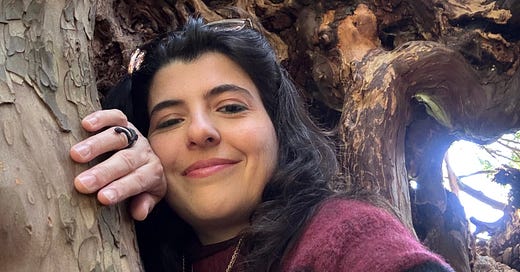


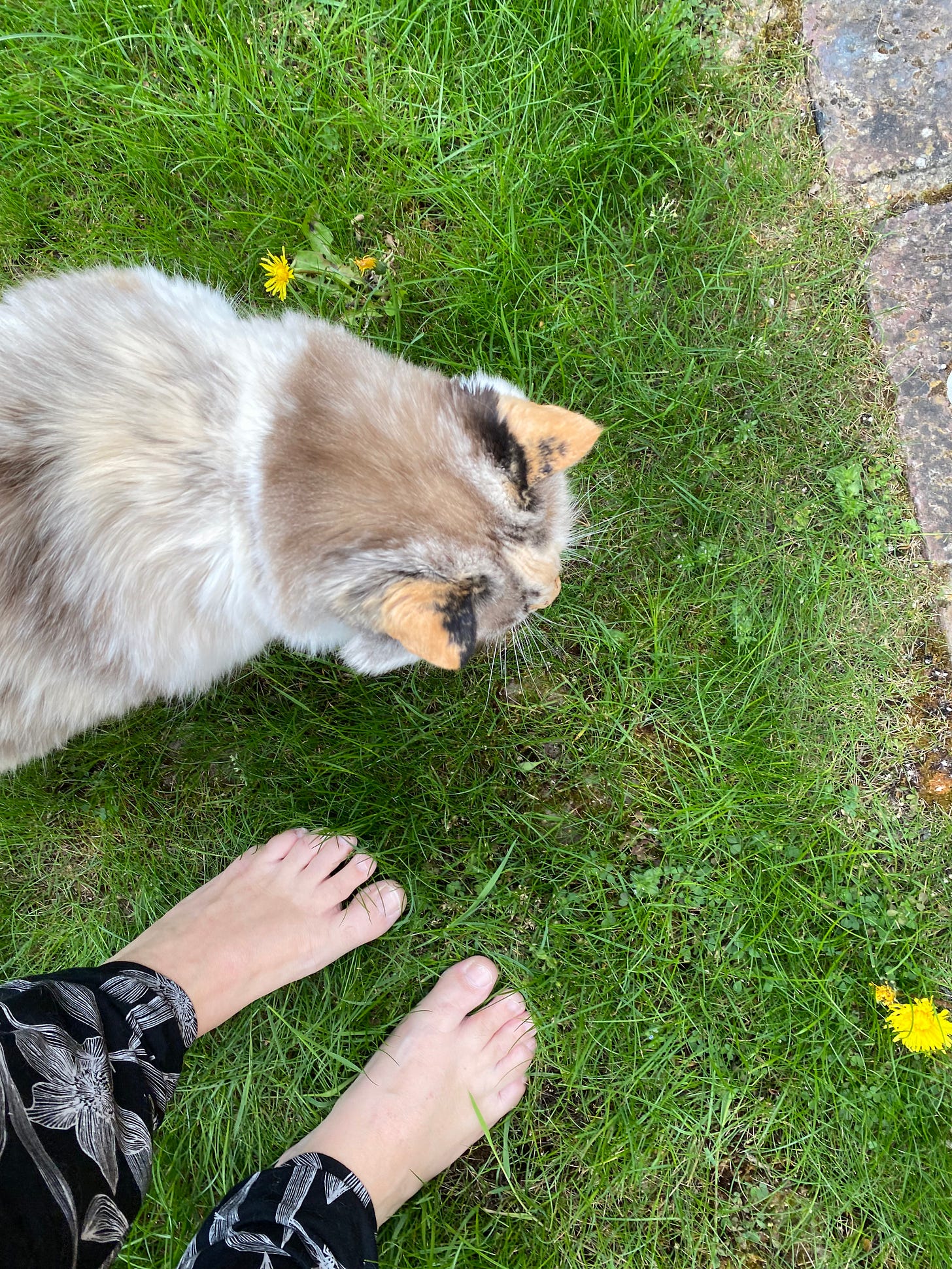
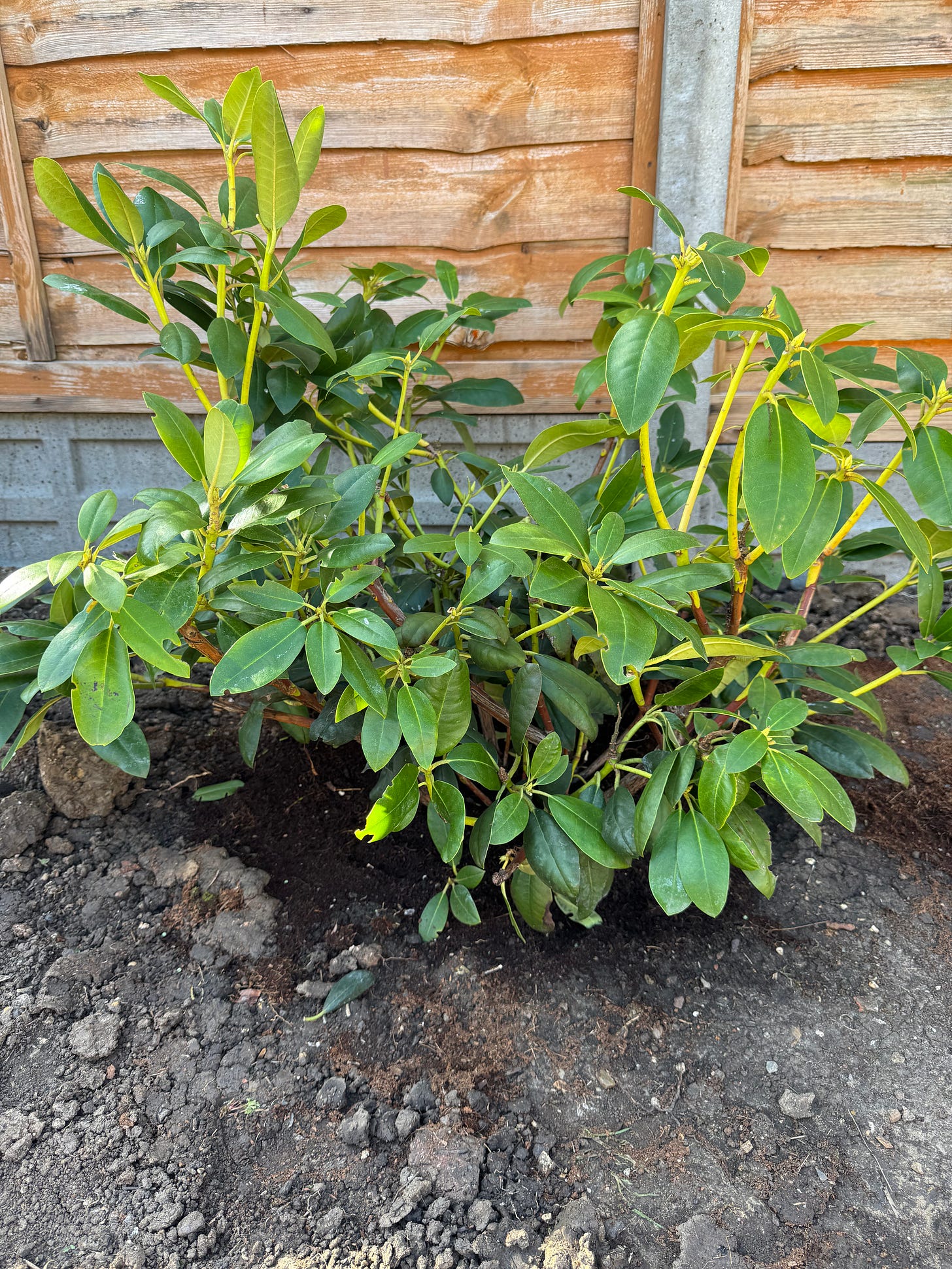
Touching story... With beautiful pictures!
Beautiful piece Marianna, it resonates so much as someone away from their home, on different land, and in temporary accommodation. Wanting to connect to the land through garden but feeling a disconnect or resistance. So glad you met that beautiful Yew - what a magnificent tree and wonderful teachings